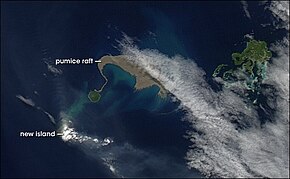Pumice raft
Pumice rafts have unique characteristics, such as the highest surface-area-to-volume ratio known for any rock type, long term flotation and beaching in the tidal zone, exposure to a variety of conditions, including dehydration, and an ability to absorb many potentially advantageous elements/compounds.
According to a team of University of Sydney scientists, it is possible that this false report may have been occasioned by pumice rafts being mistaken by the Velocity for dry land.
[4][5] Pumice rafts drifted to Fiji in 1979 and 1984 from eruptions around Tonga, and some were reportedly 30 kilometres (19 miles) wide.
In August 2019, a large floating pumice raft covering 150 square kilometres (58 sq mi) was discovered in the tropical Pacific Ocean near Late Island in the Kingdom of Tonga.
Sailors described a "rubble slick made up of rocks from marble to basketball size such that water was not visible", as well as a smell of sulfur.


